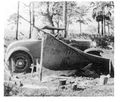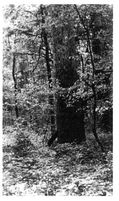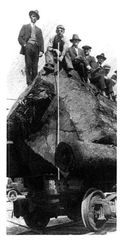The Race to Save the Lord God Bird (21 page)
Read The Race to Save the Lord God Bird Online
Authors: Phillip Hoose

Chapter Nine. Wanted: America's Rarest Bird
and
Chapter Ten. The Last Ivory-bill Forest
and
Chapter Ten. The Last Ivory-bill Forest
The profile of John Baker is drawn from three sources. First, the National Audubon Society's archives, located in Room 328 of the Fifth Avenue and Forty-second Street Branch of the New York Public Library, include Baker's correspondence, filed under “NAS records, section b, John Hopkinton Baker.” There I found Baker's quote on p. 89 (“Every plant and animal ⦔). Second, Frank Graham wrote extensively about Baker in
The Audubon Ark.
Finally, Richard C. Pough addressed Baker's “imposing” personality in two personal interviews with me in 2002.
The Audubon Ark.
Finally, Richard C. Pough addressed Baker's “imposing” personality in two personal interviews with me in 2002.


At Cornell, in the Carl A. Kroch Library at the Rare and Manuscript Collections Division, there is an extensive file of James Tanner's correspondence and work. The file, under his name, is identified as no. 2665. It consists of several boxes and is nothing less than a treasure. Here I found most of my information about his activities during his Audubon Research Fellowship, which lasted from 1937 to 1939. Tanner kept a daily journal, but only a few notebook pages from March 1938 survive in his file. However, he did compile detailed reports of his activities a half year at a time, organized chronologically, often in two- or three-day summaries. Most of this material is in Box 1. Here he tells where he went and what he found in his Ivory-bill quest, including his trip down the Altamaha River (pp. 92â93) and his explorations in Florida (pp. 93â95). Here, too, is Tanner's reaction to the cutting of trees at the Singer Tract (“Those woods should be
preserved
,” p. 99) and the valentine to his car that appears on p. 99.
preserved
,” p. 99) and the valentine to his car that appears on p. 99.
But that's not all. Tanner's Cornell file contains penny postcards sent to Arthur Allen, as well as Doc Allen's letter confirming that Tanner is “reliable and trustworthy” (p. 92). Even Tanner's expense reports are fascinating. He did everything he could to save money, including sleeping on the ground and lunching on chocolate bars, which didn't cost much.
Also in Tanner's Cornell file is his paper “The Suwannee River, 1890 and 1973,” which tells of his encounter with the men at the Suwannee River campsite (pp. 94â95).
The aims of Tanner's study and how he organized his time are detailed in his book
The Ivory-billed Woodpecker.
Here I found maps of places he visited or read about, and a good description of his research techniques. His Ivory-bill aliases (sidebar, p. 92) are found at p. 101, while comparisons between Ivory-bills and Pileated Woodpeckers (sidebar, p. 93) are at p. 2.
The Ivory-billed Woodpecker.
Here I found maps of places he visited or read about, and a good description of his research techniques. His Ivory-bill aliases (sidebar, p. 92) are found at p. 101, while comparisons between Ivory-bills and Pileated Woodpeckers (sidebar, p. 93) are at p. 2.
Later in his life, Tanner wrote two long and valuable reminiscences of his days at the Singer Tract. One, entitled “A Forest Alive,” appears in the British magazine
Birdwatch,
issue 107 (May 2001), pp. 18â24. This is the basis for most of the descriptions of the Singer forest in the first pages of chapter 10, including the story of Tanner's encounter with a wolf (p. 104), his account of rowing out onto a lake at night (pp. 104â5), of the snakes he and J. J. Kuhn encountered (p. 105), of the awesome falling of giant trees (p. 105), and of his day-end conversations with Kuhn (p. 105). A second Tanner reminiscence, entitled “A Postscript on Ivorybills,” appears in
Bird Watcher's Digest
(JulyâAugust 2000). Here Tanner described his acquaintance with “Sonny Boy” (pp. 106â9).
Birdwatch,
issue 107 (May 2001), pp. 18â24. This is the basis for most of the descriptions of the Singer forest in the first pages of chapter 10, including the story of Tanner's encounter with a wolf (p. 104), his account of rowing out onto a lake at night (pp. 104â5), of the snakes he and J. J. Kuhn encountered (p. 105), of the awesome falling of giant trees (p. 105), and of his day-end conversations with Kuhn (p. 105). A second Tanner reminiscence, entitled “A Postscript on Ivorybills,” appears in
Bird Watcher's Digest
(JulyâAugust 2000). Here Tanner described his acquaintance with “Sonny Boy” (pp. 106â9).
Tanner's conclusions about what it would take to save the Ivory-bill are best presented in his book, but they appear first in his 1939 year-end report for the Audubon Society, entitled “Report of the Ivory-billed Woodpecker Fellowship before the National Association of Audubon Societies, October, 1939,” found in Box 1 of Tanner's Cornell file. The quote that opens chapter 10, at p. 101 (“The Ivory-bill has frequently been described ⦔) is taken from p. 5 of this report. The quote at p. 112 (“less dead wood ⦔) is from p. 8. His tribute to the Singer Tract on p. 113 (“the finest stand of virgin swamp forest”) is from p. 10. Tanner makes his first ominous reference to the cutting of trees at the Singer Tract in a report entitled “Field Work in December 1937,” at p. 4, under the heading “Recent Developments in the Singer Tract.”
Chapter Eleven. The Race to Save the Lord God Bird
“The Story of the Chicago Mill and Lumber Company,” by John R. Shipley, is an 18-page unpublished company history. It was written in 1980 by a Chicago Mill employee and is available at the Washington County Historical Society in Greenville, Mississippi. It provided detailed information about the company's origins and development and logging of the Singer Tract.
Douglas Alexander's attitudes toward flappers are discussed in Don Bissell's
The First Conglomerate
(see sources for chapters 7 and 8).
The First Conglomerate
(see sources for chapters 7 and 8).

Insights about portable housing at Singer came from personal interviews with Billy Louis Fought, who lived in such a house, and Tolbert Williams. They also told me about the furious pace of Chicago Mill's logging, as did Gene Laird, in an interview at his home. Further information on Chicago Mill's cutting is found in a letter to Tanner from Louisiana conservation official George H. Buck, dated August 11, 1941, and found in Tanner's Cornell file, Box I.
Gene Laird's quote (“Those woods were
loud”)
on p. 116 came from my interview with Mr. Laird. The “Swamp Date” (pp. 118â2O) was lovingly recalled by Nancy Tanner in telephone interviews and e-mail correspondence.
loud”)
on p. 116 came from my interview with Mr. Laird. The “Swamp Date” (pp. 118â2O) was lovingly recalled by Nancy Tanner in telephone interviews and e-mail correspondence.
The John Baker collection in the National Audubon Society archives at the New York Public Library (see sources for chapter 9) is huge. Most of this material is available on microfilm. Most valuable is a sub-file labeled “The Singer Tract,” within which I found accounts of James Tanner's walk with Sam Alexander (pp. 120-21), Governor Sam Jones's provision of $200,000 to buy land at Singer (p. 122), and a copy of H.R. 9720.
The first meeting between Audubon's Baker and Chicago Mill's Griswold (“Mr. Griswold has just been with me here ⦔) on p. 122 is documented in Tanner's Cornell file, Box I (letter, Baker to Tanner, March 25, 1942). Tanner's recommendation that Greenlea Bend be saved (“it is the gem of it all”) on p. 121 comes from his 9-page typewritten “Report on Trip to the Singer Tract, Louisiana, December 1941,” found in Tanner's Cornell files.
Baker's instructions to Richard Pough to slip down to Louisiana (p. 123) and look for Ivory-bills are found in a long “Memorandum to Mr. Pough,” in the National Audubon Society's Singer Tract sub-file.
Census data for Madison Parish are found at
www.census-online.com/links/LA/Madison
. A good discussion of Executive Order 8802 is found in Ronald Takaki's
A Different Mirror
(Boston: Little, Brown, 1993), in chapter 14.
www.census-online.com/links/LA/Madison
. A good discussion of Executive Order 8802 is found in Ronald Takaki's
A Different Mirror
(Boston: Little, Brown, 1993), in chapter 14.
Chapter Twelve. Visiting with Eternity
The opening quote, on page 125, appears in Matthiessen's
Wildlife in America,
at p. 253.
Wildlife in America,
at p. 253.
In 2002 I interviewed Billy Louis Fought and his brother, Robert Fought, about what it was like to grow up on the Singer Tract as it was being logged, and about their time with the late Don Eckelberry. Likewise, Mr. Eckelberry's widow, Virginia, shared information in a telephone interview about her husband's temperament and work. Don Eckelberry described his days with the last female Ivory-bill in a wonderful chapter, “Search for the Rare Ivorybill,” in the book
Discovery: Great Moments in the Lives of Outstanding Naturalists,
ed. John K. Terres (Philadelphia and New York: J. B. Lippincott, 1961).
Discovery: Great Moments in the Lives of Outstanding Naturalists,
ed. John K. Terres (Philadelphia and New York: J. B. Lippincott, 1961).

Much firsthand information about German POWs in Louisiana came from two interviews with John Cherbini, who served as a prison guard in Tallulah during World War II. He went to New York City and escorted German prisoners to Louisiana, then supervised their work at a campground outside Tallulah. He was with them as they logged the Singer Tract.
Information on Chicago Mill and Lumber Company's wartime activities, including the manufacture of tea chests for British troops (p. 130) is found in Shipley, “The Story of the Chicago Mill and Lumber Company” (see chapter II source notes).
There is a good exhibit about the Afrika Korps soldiers in the Hermione Museum in Tallulah, including a few examples of prisoner carvings. Tolbert Williams and Gene Laird shared personal reminiscences of the POWs and took me to barns prisoners had built, with German names still carved in the doors. Good written materials include James E. Fickle and Donald W. Ellis, “POW's in the Piney Woods,”
The Journal of Southern History,
vol. 56, no. 4 (November 1990)âthe two quotes on p. 127, “When we Germans hear the word âforest,'” and “Who does not know these little red stitches,” are from p. 702 of this article. I also consulted Matthew J. Schott and Rosalind Foley,
Bayou Stalags: German Prisoners of War in Louisiana
(Lafayette, La.: self-published, 1981), and Joe Danborn, “War Is Swell,”
Gambit Weekly
(January 19, 1999). I interviewed Dr. Matthew J. Schott, a former professor of history at the University of Southwestern Louisiana (now the University of Louisiana at Lafayette), and the expert on POWs in his state. His interest began as a boy of eight, when three German POWs were assigned to trim his mother's backyard azalea bushes at a time when his three older brothers were fighting Nazis overseas. His mother gave them Cokes, explaining to Matthew that she hoped that someone would treat his brothers the same way if they were shot down or captured.
The Journal of Southern History,
vol. 56, no. 4 (November 1990)âthe two quotes on p. 127, “When we Germans hear the word âforest,'” and “Who does not know these little red stitches,” are from p. 702 of this article. I also consulted Matthew J. Schott and Rosalind Foley,
Bayou Stalags: German Prisoners of War in Louisiana
(Lafayette, La.: self-published, 1981), and Joe Danborn, “War Is Swell,”
Gambit Weekly
(January 19, 1999). I interviewed Dr. Matthew J. Schott, a former professor of history at the University of Southwestern Louisiana (now the University of Louisiana at Lafayette), and the expert on POWs in his state. His interest began as a boy of eight, when three German POWs were assigned to trim his mother's backyard azalea bushes at a time when his three older brothers were fighting Nazis overseas. His mother gave them Cokes, explaining to Matthew that she hoped that someone would treat his brothers the same way if they were shot down or captured.
The account of the showdown meeting at Chicago Mill and Lumber's office on pp. 128â29 containing the “We are just money grubbers” quote comes from a report by Audubon's John Baker entitled “For the Confidential Information of the Directors of National Audubon Society, December 15, 1943.” It is found in the Singer Tract sub-file in the Audubon archives at the New York Public Library (see sources for chapter 9). In this file I found extensive, illuminating correspondence between Baker and Richard Pough, the man assigned to keep track of the last bird, including the two Pough quotes on p. 129 (“It is sickening to see ⦔ and “I watched them cutting ⦔). Gene Laird told me, during an interview, about keeping track of the last Ivory-bill after Mr. Eckelberry had departed. The story appears on pp. 132â33.
Other books
Teaching Bailey by Smith, Crystal G.
The Mediterranean Caper by Clive Cussler
The Decadent Duke by Virginia Henley
Symbiography by William Hjortsberg
The Mammoth Book of Erotica Presents The Best of Saskia Walker by Saskia Walker
Schrodinger's Cat Trilogy by Robert A. Wilson
The Sleeping Army by Francesca Simon
El Maquiavelo de León by José García Abad
The Undertaker's Widow by Phillip Margolin
Lesbian Euro MILF (First Time Older Woman Younger Woman Romance) by Laura Lovelace
